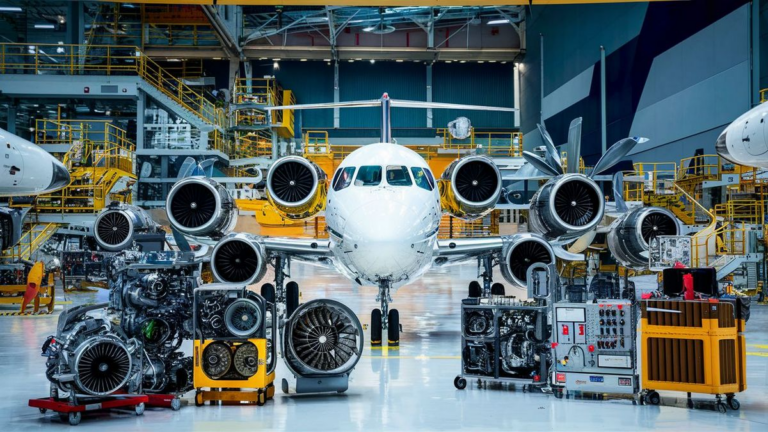In the realm of aviation, the power behind flight lies in the engineering marvels of aircraft engines. One prominent company that stands tall as a global leader in this field is General Electric (GE).
The Aviation Powerhouse – General Electric (GE)
General Electric, often recognized by its iconic monogram “GE,” has solidified its position as one of the world’s largest makers of aircraft engines. The company’s rich history dates back to the late 19th century, and since then, it has been at the forefront of technological innovation, contributing significantly to the aviation industry.
Specializing in cutting-edge technologies, GE Aviation, a subsidiary of General Electric, has played a pivotal role in shaping the modern aerospace landscape. Their engines power a diverse range of aircraft, from commercial jets to military planes, showcasing the versatility and reliability of their products.
The Engineering Excellence of GE Aircraft Engines
GE’s commitment to engineering excellence is evident in the performance and efficiency of their aircraft engines. These powerhouses are designed with precision, incorporating advanced materials and state-of-the-art technology to ensure optimal functionality and safety.
One notable innovation is the GE90 engine, known for being one of the most powerful and fuel-efficient engines in the world. This exemplifies GE’s dedication to pushing the boundaries of what is possible in the aviation industry.
Global Impact and Collaborations
GE’s influence extends far beyond the borders of the United States, with a global footprint that spans continents. The company collaborates with airlines, defense forces, and aerospace manufacturers worldwide, contributing to the advancement of aviation capabilities on a global scale.
Through strategic partnerships and collaborations, GE has been instrumental in developing cutting-edge technologies that enhance the performance, reliability, and sustainability of aircraft engines. These collaborations showcase the company’s commitment to driving progress in the aviation sector.
Environmental Stewardship
As the aviation industry evolves, the importance of environmental sustainability becomes increasingly significant. GE acknowledges this responsibility and actively engages in research and development to create eco-friendly aviation solutions.
Efforts such as the GE9X engine, designed with a focus on fuel efficiency and reduced emissions, highlight the company’s commitment to balancing technological advancement with environmental stewardship. This dedication positions GE as a key player in shaping the future of sustainable aviation.
General Electric’s legacy in the aviation industry as one of the world’s largest makers of aircraft engines is deeply rooted in a commitment to excellence, innovation, and global collaboration. Through a storied history and a relentless pursuit of engineering perfection, GE continues to propel the world forward into the future of flight.
Advancements in Aerospace Technology
Beyond General Electric’s contributions, various technological advancements continue to redefine the aerospace landscape. Innovations in materials, propulsion systems, and avionics are shaping the future of aviation, influencing the design and capabilities of next-generation aircraft.
Materials Revolution in Aviation
The use of advanced materials, such as carbon composites and titanium alloys, has revolutionized aircraft manufacturing. These materials offer enhanced strength-to-weight ratios, contributing to fuel efficiency, increased durability, and overall performance improvements in modern aircraft.
| Material | Advantages |
|---|---|
| Carbon Composites | High strength, low weight, corrosion resistance |
| Titanium Alloys | Excellent strength-to-weight ratio, heat resistance |
Frequently Asked Questions
- Q: What are the key materials revolutionizing aircraft manufacturing?
- A: Advanced materials like carbon composites and titanium alloys play a crucial role, offering improved strength, durability, and weight advantages.
- Q: How does material innovation contribute to fuel efficiency in aircraft?
- A: The use of lightweight materials, such as carbon composites, reduces overall aircraft weight, leading to improved fuel efficiency and reduced environmental impact.
Global Collaborations for Space Exploration
Beyond aviation, global collaborations are driving advancements in space exploration. Countries and private entities are joining forces to push the boundaries of human spaceflight, satellite technology, and interplanetary exploration.
International Space Station (ISS) Partnerships
The International Space Station serves as a testament to international cooperation in space exploration. Collaborations between NASA, Roscosmos, ESA, and other space agencies showcase the ability to unite for scientific research, technological innovation, and the pursuit of knowledge beyond Earth’s atmosphere.
Future Trends in Sustainable Aviation
Looking ahead, sustainable aviation remains a focal point for industry leaders. Companies are investing in research and development to create eco-friendly solutions, addressing environmental concerns and shaping the future of air travel.
Hybrid and Electric Propulsion
Hybrid and electric propulsion systems are emerging as potential game-changers in sustainable aviation. These technologies aim to reduce carbon emissions, noise pollution, and dependence on traditional fossil fuels, paving the way for a greener and more sustainable aviation industry.






